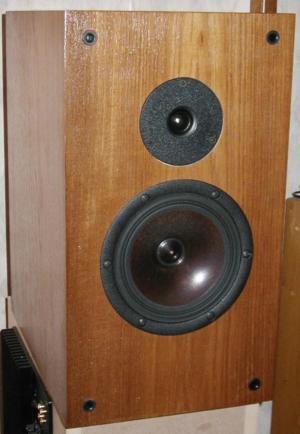
Vifa XT18/XG18 comparison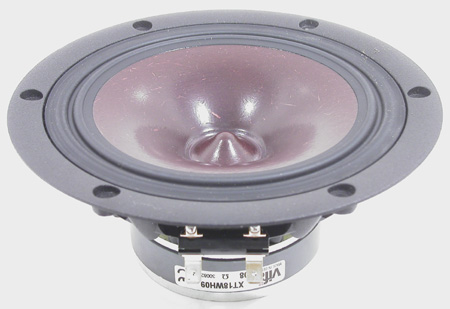 XT18WH09-08 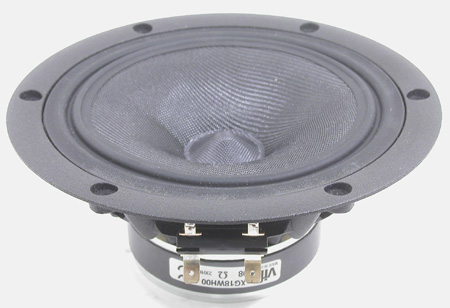 XG18WH00-08 IntroductionI first used the Vifa XT18 several years back when I built my Asterion design (with the OW1 tweeter). Since then the Asterion has been my reference speaker that I compare all new designs to. The Asterion is also my favorite speaker because it is detailed and analytical while being smooth and musical. I've been a big fan of the XT18 driver since I first heard it. Recently somebody offered to buy me a set of XG18 drivers for some crossover and speaker design work I have been doing for him. I couldn't resist the offer since I've been itching to hear the XG18 considering it costs nearly $30 less than the XT18 and the only difference is the cone (and you know how interested I am in learning how different cone materials affect the sound). So I got the drivers, broke them in a bit and installed them in my Asterion cabinets. I measured both the XT18 and the XG18 mounted in the cabinet (frequency response and impedance response but not T/S). I then re-tuned the Asterion crossover to accept the XG18 response which is 1 dB lower in sensitivity. The only crossover modification required was to add a 50 ohm resistor in parallel with the tweeter when using the XG18. As you'll see below the responses are very similar between the two designs except the XT18 version is about 1 dB more sensitive overall.In this discussion I'll compare the T/S parameters of these two drivers as well as measurements taken by John Krutke for both drivers including frequency response and distortion plots. Then I'll present my frequency response and impedance measurements for both drivers mounted in the Asterion cabinet as well as the responses for the two Asterion designs. Finally I'll discuss my impressions of the two drivers. Manufacturer's T/S parameter comparisonIn this section I'll discuss the differences between the two drivers based on the data provided by Tymphany (owner of Vifa). The spec sheets for the Vifa XT18 and Vifa XG18 are available at the Tymphany website. By the way, Tymphany is dropping the Vifa name so these drivers will now be known as the Peerless XT18 and Peerless XG18. If you click on the speaker name links in the previous sentence you can compare the frequency response measurements for these drivers as well as T/S parameters but I'll be listing them below. Based on the frequency response measurements taken by Tymphany the XT18 has more of a rising response with a stronger upper midrange while the XG18 has a bit of a peak in the 200 Hz region. The top end of the XT18 response is a bit smoother and more extended. They definitely "look" like they should sound different.At this point I'll comment on the physical differences between the drivers. As far as I can tell, the only difference between the XT18WH and the XG18WH is the cone and even the cones are very similar. They have the same shape and a similar feel in terms of stiffness and damping. They are both very stiff near the center but begin to flex more towards the edges. I'm trying to get more data from Ken Kantor at Tymphany on the cone differences. Based on the specifications the XG18 has a moving mass of 11.8 grams while the XT18 only weighs 10.7 grams. This gives the XG18 a lower resonance frequency of 34 Hz as opposed to 38 Hz for the XT18 and lower sensitivity of 86 dB as opposed to 87 dB for the XT18. Below is a chart listing some of the T/S parameters (most of the ones not listed are identical between the drivers).
Now looking at the differences in the T/S parameters it is obvious that the XG18 prefers a slightly larger enclosure. I don't know how the cone differences affect the Vas property but perhaps if the XG18 cone flexes more you will get a lower Vas relative to the XT18 (unless there are differences in the spider and surround that I am unaware of). The mechanical Q of the XG18 is also higher and I don't know enough about driver parameters to explain this. Otherwise they are very similar drivers. John Krutke's Measurements (ZaphAudio)The plots in this section are based on measurements taken by John Krutke. These plots are taken from John Krutke's site, www.zaphaudio.com, where there is a detailed comparison between several drivers. I will be presenting frequency response measurements as well as distortion measurements. The distortion plots give the 2nd through 5th order harmonic distortion levels. Harmonic distortion occurs when a higher frequency harmonic is produced by the fundamental tone. For example if the fundamental tone is 1kHz, then the 2nd order harmonic would be 2kHz, the 3rd order harmonic is 3kHz and so on. The plot tells you what the sound level of that tone is at each frequency relative to the fundamental "1st order" tone. The lower the harmonic level, the better. First I will present the frequency response plots. To see the XG18 response place your mouse over the picture and to see the XT18 response move your mouse off of the picture.
John's measurements reveal that the XG18 has a lower output above 300 Hz by about 1 dB which agrees with the data presented by Tymphany and my data as you'll soon see. However, John's data indicates that the XG18 is smoother above 1kHz while my measurements and Tymphany's measurements indicate the opposite. All of our measurements show that the XT18 has a more extended response probably due to the lighter cone. Below is a plot of the harmonic distortion for the XT18. Move your mouse over the picture to see the XG18 data. 
In general the XG18 has slightly lower distortion than the XT18 above 100 Hz but they have a few areas where the XT18 has lower distortion for certain harmonics. Below 100 Hz the XG18 has higher even order harmonics than the XT18. Neither one is excellent below 100 Hz but I suppose the bass distortion is still not that bad and may be lower at lower listening levels because I think that this series of drivers is somewhat excursion limited which can show up as bass distortion at higher levels. Another source of bass distortion could be from the cone flexing which I believe both do especially near the edges of the cone. This is why a good metal cone driver often excels in bass distortion performance due to the stiff cone. Even order distortion in the bass range can make the bass sound a bit fuzzy with less definition which could probably be compared with the type of bass sound you typically get when using a tube amp. I think based on the fact that the XG18 is $30 less expensive and in general has lower distortion John Krutke decided to stick with that model and abandon the XT18. RJB Audio XT18/XG18 MeasurementsIn this section I will present the measurements taken by me using my calibrated ECM8000 microphone and SoundEasy. These measurements represent the response of the drivers mounted in my Asterion cabinet so the baffle diffraction effects and box tuning properties are reflected in the responses. The cabinet is roughly 28 liters with a baffle that is 10" wide by 18" tall. It is ported with a tuning frequency in the upper 30's. This enclosure is a bit large for the XT18 and gives a deep but sloped bass response while it is the perfect size for the XG18 to get a nice flat response with deep bass (f3 in the upper 30's). Below is a plot of the measured frequency response for the XT18 driver mounted in the Asterion cabinet. The response above 300 Hz is based on a gated measurement and below 300 Hz is based on a nearfield measurement. The response reflects the true sensitivity of the speaker with 1 watt of power at a distance of 1 meter. Move your mouse over the picture to see the response of the XG18 driver.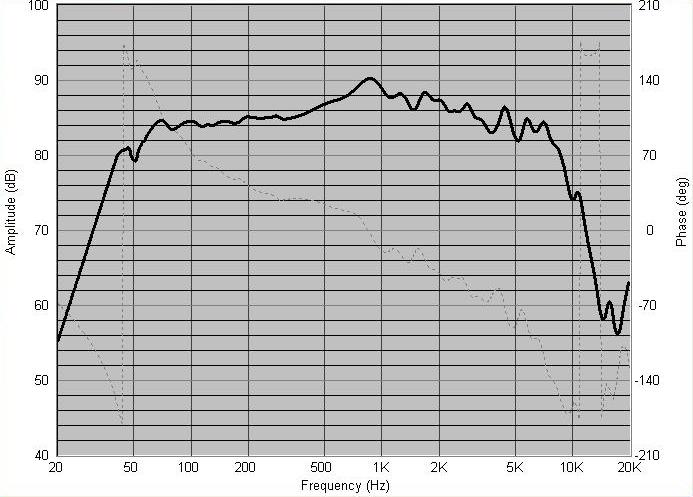
As you can see from the plots above my measurements are consistent with the previous data and reveal that the XG18 has lower output above the bass region. My measurements coincide with Tymphany's measurements regarding the XT18 having a smoother top end response than the XG18. Both the XG18 and XT18 seem to have an extended top end based on my measurements. The responses are very similar and both have dips and peaks at the exact same frequencies. However, the dips that show up above 1 kHz are a bit more severe with the XG18 which can show up in the frequency response of a system if you are crossing in the 2 kHz range. I noticed this to be the case with my Asterion design as you'll read below. The XG18 has slightly deeper bass mostly because the sensitivity is lower and the midrange is shelved down my 1 dB (so you would expect the XT18's -3dB point to coincide with the XG18's -2dB point). Below is a plot of the impedance response for the XT18 driver mounted in my 28L ported Asterion cabinet. Move your mouse over the picture to see the XG18 impedance data. 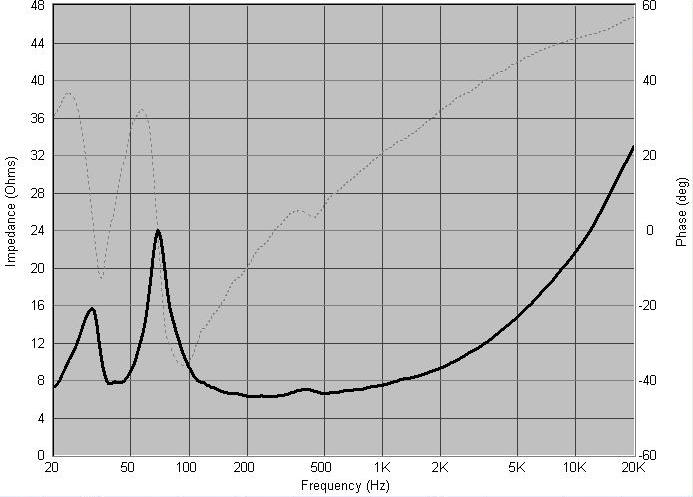
As you can see from the plots the XG18 has a slightly lower resonance frequency and the voice coil inductance is a tiny bit different represented by the slight difference in impedance at higher frequencies. Otherwise they are both very similar. They both have that impedance "blip" around 300 Hz which could be indicative of cone issues. Asterion XT versus Asterion XG
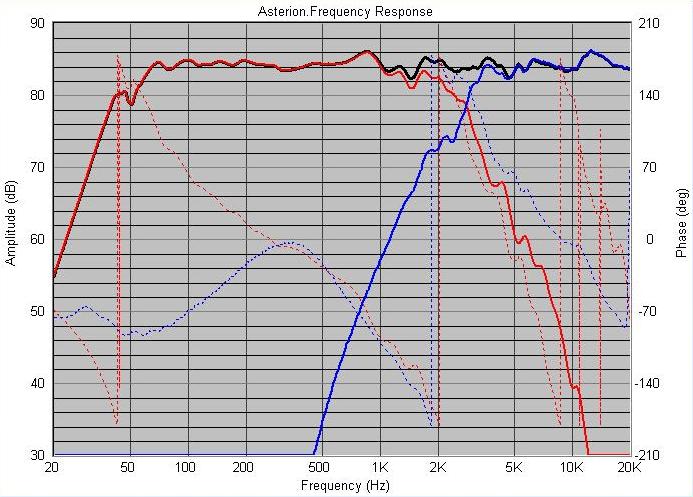
Based on the plots you can see that the Asterion XT has about 1 dB more sensitivity than the Asterion XG due to the stronger midrange response of the XT18 driver. This means that the -3dB point for the bass response of the Asterion XG is lower in frequency. Also you could say that the Asterion XG has 1 dB more baffle step compensation than the XT18 version. The responses mimic each other pretty well except some of the dips in the XG18 response above 1kHz are a bit more severe than the XT18 version. The Asterion XT is flatter overall. The XG18 has a slight peak in the upper bass region relative to the XT18 version. Other than these few things they have nearly the same response if you were to scale them by 1 dB to match. Both designs are within +/-2 dB from 40 Hz to 20 kHz although the Asterion XT is flatter in a few wide ranges. Listening ImpressionsI've listened to the Asterion with the XT18 driver for years and it is still my favorite design. It is the design that I strive to surpass and have yet to do so. It isn't the most neutral, detailed, analytical speaker but it compromises some of those characteristics in order to gain smoothness, musicality and depth. It is just a pleasant speaker to listen to. When I substituted the XG18 woofer in the cabinet and measured the responses I found out that adding a 50 ohm resistor in parallel with the tweeter was all that was necessary to get a nice response similar to that of the original Asterion with the XT18 woofer (as can be seen in the previous plots). When I first did the comparison I found it hard to hear a difference between the woofers partly because there was a 5 minute lag between switching the drivers and adding the 50 ohm resistor. I am much better at picking out differences with quicker switches between speakers but I only have one set of cabinets. At first I thought that they were nearly identical. Then my friend came over to listen to them. He immediately could tell the difference and once he pointed out what he heard and I knew what to listen for it was obvious to me as well.We concluded that the XG18 had a different bass balance than the XT18 which made it a bit stronger below 80 Hz relative to the midrange. He also said that the bass sounded a bit woolly with the XG18 relative to the XT18 (this could be due to the higher 2nd and 4th order distortion of the XG18) while the bass with the XT18 was better defined. We both agreed that the midrange had a different character between the drivers and the most prominent difference was in the upper midrange. The XT18 seems to have a stronger upper midrange sound that gives it a bit more edge and detail while the XG18 sounds a bit smoother and mellower. My friend said that the smoother sound of the XG18 was easier on your ears with certain music but sounded a little bit veiled compared to the XT18. If you examine the response plots for the two designs above you'll see that the XG18 has a stronger response below 200 Hz and the dips above 1kHz are a bit deeper. These are probably some of the things we are hearing. I asked my friend which one he would pick if he was to choose one. He said the XG18 because it was so much cheaper but if the prices were the same it would be a tough decision. I've listened to both for a while and I prefer the added detail of the XT18 driver. The XG18 is a bit smoother and seems better with poorly recorded material but I miss the edge and midrange detail that the XT18 has to offer and prefer the better defined bass sound. Based on my experiences with different driver materials I'd have to conclude that the XT18 sounds more like a metal cone woofer while the XG18 sounds more like a poly cone woofer but both really fall into the category of paper cone woofer based on their stiffness and damping as far as I can tell. The XG18 seems like it has a less rigid cone based on my listening experiences and technical evaluation but I may be wrong. Either way they are both excellent drivers. However, I would give the edge to the XT18 based on my listening impressions. But is that extra detail and 1 dB of sensitivity worth the extra cost? I guess my only complaint about either driver is the distortion that creeps in below 200 Hz does hurt the upper bass and lower midrange definition a little bit but I don't notice it that much at lower listening levels. It actually adds a bit of musicality to the driver that is pleasing and may enhance the soundstage depth a bit. However, if you want the best performance out of either of these drivers I would use them as a midrange in a three way speaker and high pass filter them above 250 Hz. I did this with my Astorius and Astorius RS designs and it really cleans up the bottom end of the XT18 driver especially when using a metal cone woofer for the bass duties as I did with these designs. I'm planning on using the XG18 drivers in a future design using the same Asterion sized cabinet but with the Seas 22TAF/G tweeter. The cost of drivers will be half of the original Asterion design and the performance should still be rather good. Then I'll compare the Asterion SE (the new XG/22TAF design) with the original Asterion side by side. ConclusionSo that wraps up my comparison of the XT18 and XG18 drivers. I think I covered everything pretty thoroughly although some of my conclusions are far from proven and a lot of my analysis is subjective. I still think that my experiment is pretty well controlled and having three sources of data for the drivers helps fortify my analysis. If you have any comments regarding my analysis please email me with your thoughts. If there is anything that you think I should add to this analysis please let me know as well.Updated Listening ImpressionsI've had a chance to listen to the XG18 drivers a bit more and am starting to like them a bit more. I've found that there are some CDs that I used to find a bit harsh and slightly fatiguing with the XT18 woofers but sound a lot smoother and less fatiguing with the XG18 woofers. For example, Counting Crows CDs are a bit easier on your ears with the XG18 drivers because those CDs tend to have a lot of upper midrange energy and edge to them. Some female vocalists like Sarah McLachlan and Natalie Merchant have a bit of a whispyness and edge to their vocals with the XT18 drivers but sound a bit smoother with the XG18 drivers. So once again it comes down to what your music preference is as to which driver you might prefer. Both drivers sound excellent and I would have to say that there really isn't one clear winner. It all depends on the type of sound you prefer. |
